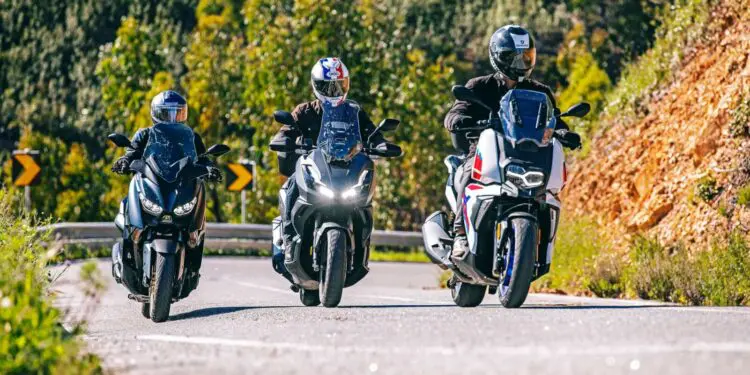With the 2024 MotoGP season about to begin, we remember our trip to the Algarve International Circuit in Portimão in the 2023 season. Three scooters with only one destination, the MotoGP World Championship.
Combining work with fun is always ideal! That’s why this year we decided to go to the Portimão MotoGP with a group of colleagues and friends. We were missing the motorcycles, so we took three medium-displacement scooters and hit the road. Do these three models have the minimum capabilities for a trip of about 750 kilometers, with safety and comfort? That’s what we went to find out!
At the beginning of this work, it is important to clarify that this is not a traditional comparison, although we can draw many conclusions. It is more important to show how three scooters, excellent for daily use in the city and surrounding areas, will behave on a short trip. We also know that, despite personally appreciating automatics – especially in this displacement range between 300 and 400 cc – it is perfectly understandable that these are not the most exciting motorcycles for sporty driving on a mountain road on the way to the races. Not even for riding in the midst of thousands of motorcycles, with license plates from different countries, where we always try to find the “racing” motorcycles or the most peculiar ones that we rarely see in Portugal. And in the midst of so much noise, which is usual in these races, it is also strange to accelerate with these automatics and hear little or nothing, as if we were riding electric motorcycles. Still, the landscape is changing, and if before the parking lot of a GP was composed of 90% sports motorcycles, nowadays it is not quite like that anymore. But, moving on!
THE MODELS
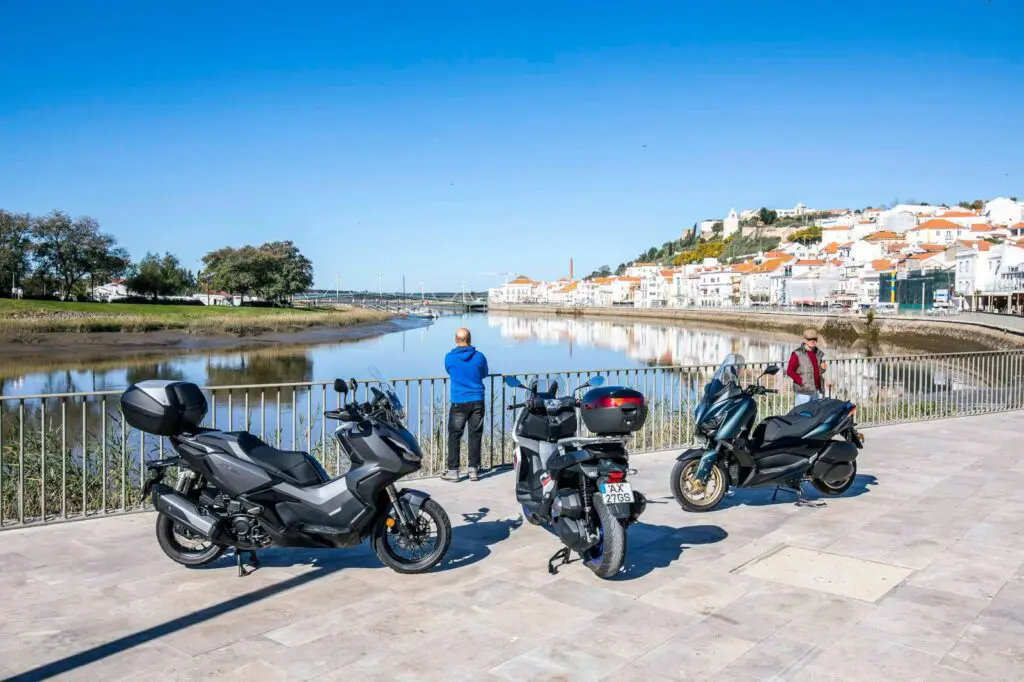
It is a relatively recent novelty in the Japanese manufacturer, distinguishing itself from the Forza 350, especially in terms of chassis and riding position. The single-cylinder engine delivers 21.5 kW of power and the maximum torque is 31.5 Nm, in a package weighing 186 kg in running order. Of the three models, it is the only one that incorporates an adjustable windshield height, as well as an inverted fork at the front. In this case, it is important to say that this is indeed an off-road DNA scooter, as in front of us we have a wide handlebar and a minimum ground clearance of 145 mm. The rear Showa shock absorbers also look excellent, and the tires are the mixed Metzeler Karoo Street.
YAMAHA XMAX 300 TECH MAX
We tested a 2022 version, but the top-of-the-line Tech Max, therefore filled with exclusive details. Special seat and grips, aluminum footrests, specific cushions in the glove compartments, other graphics, etc., are highlighted in a scooter that, like the others, has traction control and keyless ignition. The ’22 instrumentation still consists of large analog displays, but we really like the amount and quality (simple) of the information given to us, as well as the enormous storage capacity under the seat and through the two front glove compartments. The single-cylinder engine delivers 20.6 kW of power and the maximum torque is 29 Nm, with this XMAX having a weight of 180 kg and mounting Michelin tires that are more city/touring-oriented than sporty.
ON THE ROAD
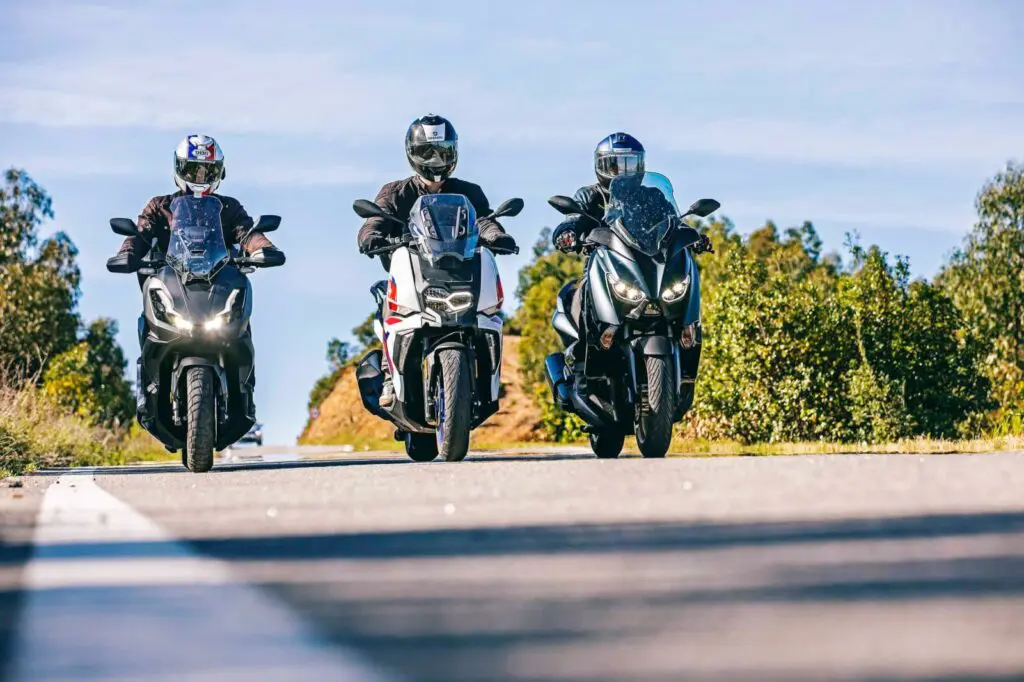
Our route was simple. Some initial highway, first stop for some photos and rest in Alcácer do Sal, and then a national road to São Marcos da Serra, where we ventured into the Serra de Monchique until we reached AIA. On the way back, the same thing, plus mandatory stops for gas and bifanas!
First aspect to highlight: each one in its own way, they are all excellent, and only by changing scooters on the same day do we realize where each one stands out. In Yamaha, we really liked the quality of the finishes, cargo space, and smoothness of the engine. The single-cylinder engine has a good start (it’s not very strong), but it needs less rotation than the engines of the competitors – it always seems to follow effortlessly – and it stretches a lot, with less engine braking. This means that it easily reaches speeds around 155/160 km/h, and it always consumes less fuel. Although this scooter was ridden without a top case and made fewer kilometers with a passenger, the average fuel consumption was around 3.4 l/100 km at a brisk pace!
In some aspects, however, the weight of the years is noticeable in the overall package, especially in two aspects: the rear shock absorbers are somewhat limited, especially when the asphalt is not completely smooth (making it somewhat bouncy); the brake levers are too far from the hand (without adjustment) and have a too hard feel, requiring some force for quick stops. It is not the most emotional in driving, but it is a quality scooter, also offering good lighting and many premium details.
BMW is clearly the most exciting in driving. The engine is strong, the driving is fun, and it has good braking power, with excellent lever feel despite the lack of adjustment. We feel that it has a relatively low center of gravity and the wheels seem to always stick to the ground, almost like a common road motorcycle, with safety and good grip from the Pirelli tires. As for the suspensions, they are soft and greatly benefit comfort, never compromising unless you ride on bad roads or ride faster with a passenger, in which case they can bottom out. The driving position is very pleasant, and it is truly a fun option in the city and surrounding areas as long as the rider does not need a huge cargo space (otherwise there is always the option of a top case).
As for Honda, it stood out above all for its more “trail” driving position and more capable suspensions, which are a bit stiff for everyday use, but can handle everything when riding with a passenger or on rough roads. As for the engine, although it is very smooth, it seems slower than those of the competitors, but in reality, it is only slightly slower than the automatic competitors starting from 120 km/h.
CONCLUSION
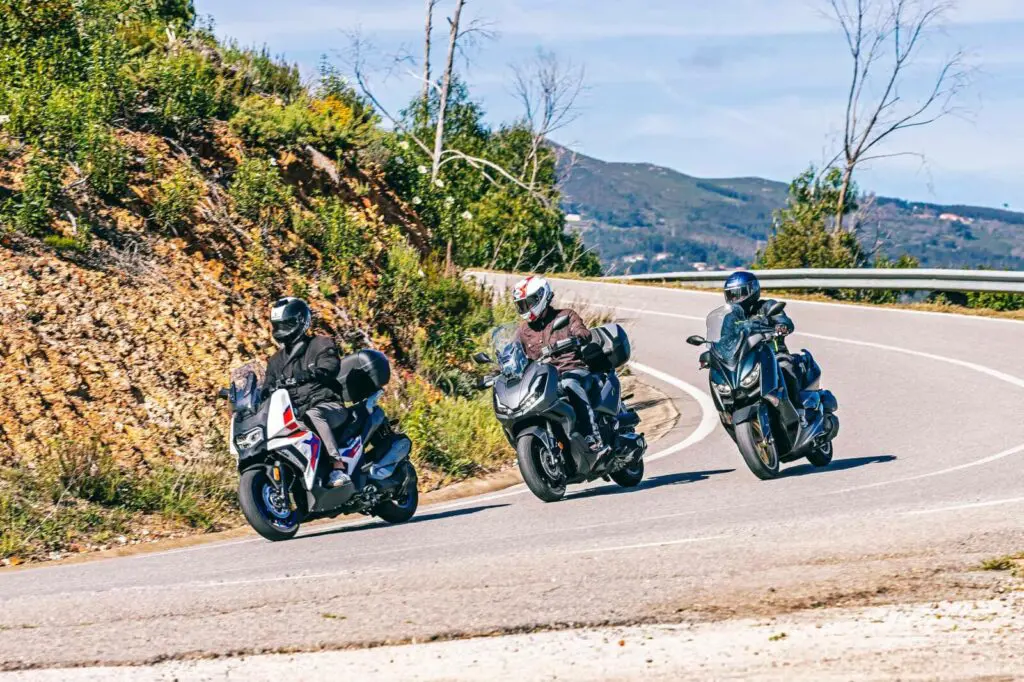
In this case, there are several. The first is that a medium-displacement scooter makes a very comfortable and safe trip of 300 kilometers. With cruising speeds around 130 km/h, we can exit the highways and save not only on tolls but also on fuel consumption, which is at most just over 4 liters per 100 kilometers traveled. Comfort is high, for both the driver and passenger, and under the seat we can store all the “stuff” that we could only carry on a motorcycle if it were equipped with a set of panniers.
As for these three models, as you may have noticed, they stand out in various aspects. Yamaha has the advantage in cargo space, refinement, and fuel consumption; BMW is the most fun but also the most expensive, and Honda prioritizes performance on poorly paved roads, even when the passenger is present. We also liked Honda’s aerodynamic protection, while BMW’s is almost absent, and Yamaha’s provides protection but generates some turbulence.
And if we had a lot of fun in Serra de Monchique – even more than we expected – it was with the BMW that we enjoyed the most, with the ADV being clearly more effective on sections of less-than-perfect pavement. With the XMAX, as long as we’re not pushing the limits, it also rides comfortably and safely.
Three options, each with its own style, capable of offering a lot for a very acceptable price, in a segment full of interesting proposals.
AS A PASSENGER TO THE ALGARVE
GOOD OVERALL COMFORT
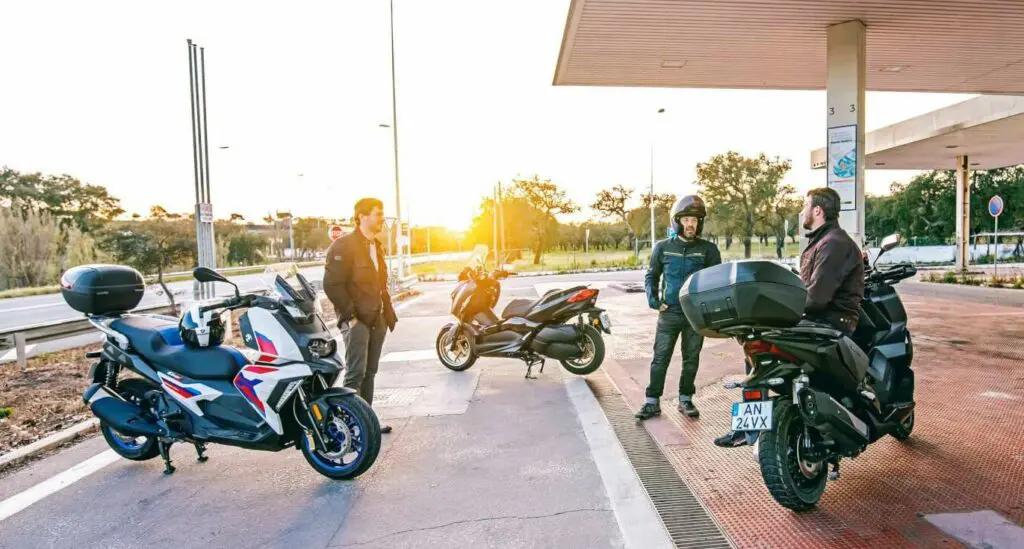
In this scooter trip to the Algarve as a passenger, there were three completely different experiences, however, some expectations were exceeded and others confirmed. The first part was done on the BMW C 400 X, a scooter that can deliver good performance with two people and maintains the ideal comfort for a long journey. It is important to mention that, as a passenger, the top case of the German model and the hand supports were very helpful in maintaining posture during the trip, as well as the spacious and soft seat made a difference compared to the other two competitors in this experience.
Next, I moved on to the Honda ADV 350 which, as expected, can be described in one word, consistency. Honda’s trademark for many is the consistency of its products, and in this case, it was exactly what I felt. Whether on winding or open roads, the Japanese set does not compromise on comfort, performance, and especially solidity. Of the three scooters, I found this one to be the most “motorcycle-like” with two people, with a comfortable seat that is sufficient for a long journey and an ideal top case to offer the correct posture to the passenger. The suspensions performed very well and never compromised comfort and safety during the trip, although the BMW revealed a greater seating comfort.
Finally, but not least, the Yamaha XMAX fell slightly below the others in terms of comfort. Its seat is the smallest of the three and the firmest, so comfort here decreased slightly, but it is worth adding that it was the only scooter without a top case. The side handles for the hands are also too wide to grip securely, so it is a comfortable scooter but slightly below the level of its rivals.
BMW C 400 X
ENGINE single-cylinder, liquid-cooled
DISPLACEMENT 350 cc
POWER 25 kW @ 7,500 rpm
TORQUE 35 Nm @ 5,750 rpm
TRANSMISSION automatic
FRAME steel tubular
FUEL TANK 12.8 liters
FRONT SUSPENSION telescopic fork 35 mm, travel of 110 mm
REAR SUSPENSION dual shock absorber, travel of 112 mm
FRONT BRAKE 2 discs of 265 mm
REAR BRAKE disc of 265 mm
FRONT TIRE 120/70 R15
REAR TIRE 150/70 R14
WHEELBASE 1,560 mm
SEAT HEIGHT 775 mm
WEIGHT 206 kg
MSRP (from) €7,100
HONDA ADV 350
Single-cylinder LIQUID-COOLED engine
DISPLACEMENT 330 cc
POWER 21.5 kW @ 7,500 rpm
TORQUE 31.5 Nm @ 5,250 rpm
AUTOMATIC TRANSMISSION
STEEL TUBULAR FRAME
FUEL TANK 11.7 liters
FRONT SUSPENSION inverted telescopic fork
REAR SUSPENSION dual shock absorber
FRONT BRAKE 256 mm disc
REAR BRAKE 246 mm disc
FRONT TIRE 120/70-15
REAR TIRE 140/70-14
WHEELBASE 1,520 mm
SEAT HEIGHT 795 mm
WEIGHT 186 kg
MSRP (from) €6,580
YAMAHA XMAX 300
Single-cylinder LIQUID-COOLED engine
DISPLACEMENT 292 cc
POWER 20.6 kW @ 7,250 rpm
TORQUE 29 Nm @ 5,750 rpm
AUTOMATIC TRANSMISSION
STEEL TUBULAR FRAME
FUEL TANK 13 liters
FRONT SUSPENSION telescopic fork, 110 mm travel
REAR SUSPENSION dual shock absorber, 79 mm travel
FRONT BRAKE 267 mm disc
REAR BRAKE 245 mm disc
FRONT TIRE 120/70-15
REAR TIRE 140/70-14
WHEELBASE 1,540 mm
SEAT HEIGHT 795 mm
WEIGHT 180 kg
MSRP (starting at) €6,795

